Navigation
Install the app
How to install the app on iOS
Follow along with the video below to see how to install our site as a web app on your home screen.
Note: This feature may not be available in some browsers.
More options
Style variation
-
Congratulations cowski on being selected by the Eng-Tips community for having the most helpful posts in the forums last week. Way to Go!
You are using an out of date browser. It may not display this or other websites correctly.
You should upgrade or use an alternative browser.
You should upgrade or use an alternative browser.
Motorcycle Center Stand Effort Calculation
- Thread starter Roshan059
- Start date
- Status
- Not open for further replies.
AIUI (which may well be wrong) you push the stand down till it reaches the ground then, hold the stand there, pull up on the handle bars.
So the work done by this force (lifting the handle bars) is equal to the work done (lifting the bike CG).
I'd draw a FBD of the initial and final positions.
another day in paradise, or is paradise one day closer ?
So the work done by this force (lifting the handle bars) is equal to the work done (lifting the bike CG).
I'd draw a FBD of the initial and final positions.
another day in paradise, or is paradise one day closer ?
- Thread starter
- #4
JohnRBaker
Mechanical
I can't help but get the feeling that this sounds like something you'd find on a college exam, or at least as a classroom exercise. I could be wrong, but...
John R. Baker, P.E. (ret)
Irvine, CA
Siemens PLM:
UG/NX Museum:
The secret of life is not finding someone to live with
It's finding someone you can't live without
John R. Baker, P.E. (ret)
Irvine, CA
Siemens PLM:
UG/NX Museum:
The secret of life is not finding someone to live with
It's finding someone you can't live without
- Thread starter
- #6
@John Baker. I'm trying to get a motorcycle up and running with new designs. But I don't wanna do some random stuff of buying and fixing things. I would rather like to go in deep get as much as knowledge and have my own pedia. Let me know if someone can actually help. On FBD, and reaction forces. I understand FBD is basic but sometimes becomes difficult for me to visualise
sure ... FBD = Free Body Diagram (if you don't know what that means, please do your own research)
as hinted at ... if this is school work, please review the "posting guidelines" dialogue box on the LH side of the screen, in particular "students click here".
another day in paradise, or is paradise one day closer ?
as hinted at ... if this is school work, please review the "posting guidelines" dialogue box on the LH side of the screen, in particular "students click here".
another day in paradise, or is paradise one day closer ?
The calc requires knowing the location of the center of gravity of the motorcycle and the geometry of the center stand including pivot point and center stand foot peg. Computing work to lift the bike equal to work of operator on center stand foot peg might be simpler, but still requires knowledge of center stand geometry.
JohnRBaker
Mechanical
At least the distance from the pivot point to where the stand touches the ground. Also, you'll need to know the angle of this line, from the pivot point to where the stand touches the ground, relative to vertical as it will be at that angle that the weight of the bike will start to be lifted. And the center of mass is important since we know that some of the weight will be supported by, I assume, the front tire, so you need to estimate the final weight distribution between the front tire and the stand.
John R. Baker, P.E. (ret)
Irvine, CA
Siemens PLM:
UG/NX Museum:
The secret of life is not finding someone to live with
It's finding someone you can't live without
John R. Baker, P.E. (ret)
Irvine, CA
Siemens PLM:
UG/NX Museum:
The secret of life is not finding someone to live with
It's finding someone you can't live without
BrianPetersen
Mechanical
It's been decades since I've owned a motorcycle with a center-stand (I think I've only ever owned two), but I believe there's generally a "pedal" of sorts on the center stand that one is meant to step on while also simultaneously pulling up on a handle of some sort that is attached to the bike itself. The pulling-up action unweights the bike from the wheels/center-stand, reducing the amount of torque needed to be applied at the pedal, but this is also going to mean that the situation is indeterminate, because it will depend on how the operator splits the force that they apply between lifting-up the bike and pressing-down the pedal/lever on the stand.
JohnRBaker
Mechanical
Here's some shots showing the center stand on one of my bikes, a 1968 Honda 305 Super Hawk:
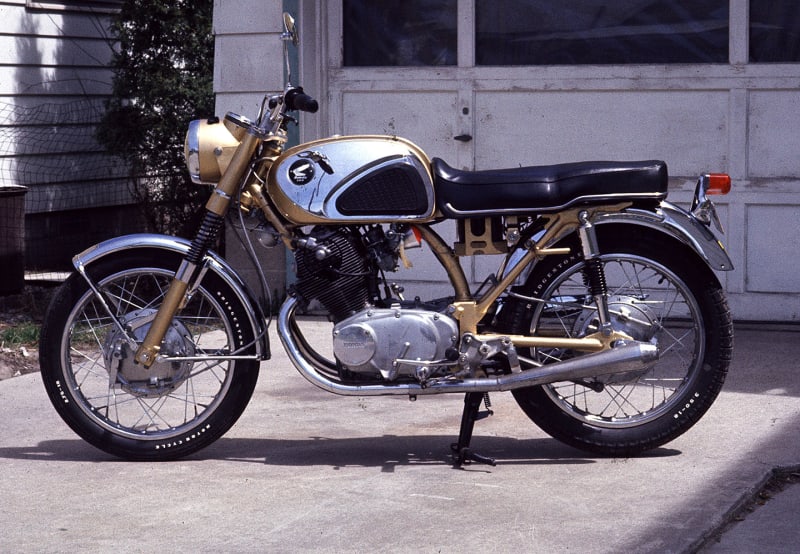
April 1974 (Minolta SRT-101)
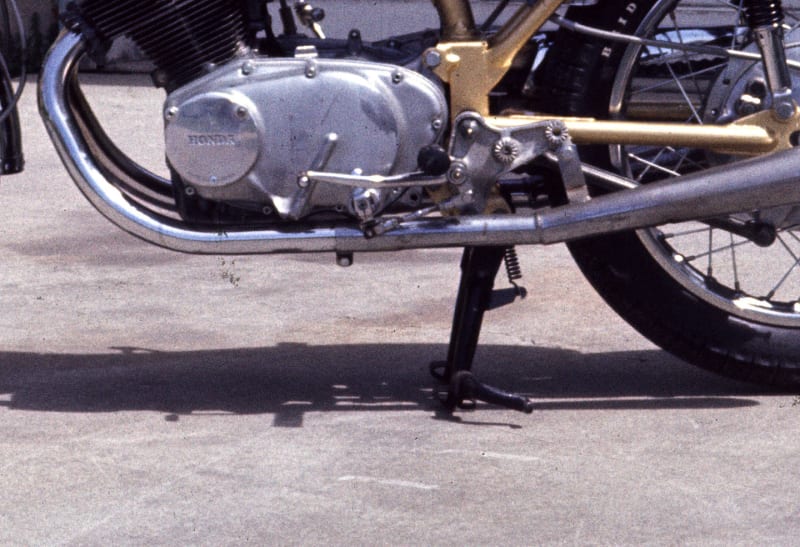
April 1974 (Minolta SRT-101)
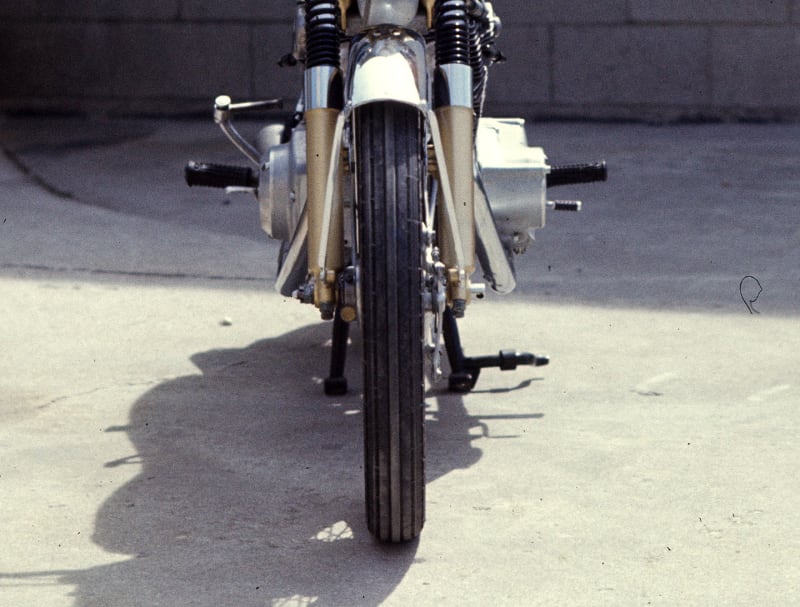
April 1974 (Minolta SRT-101)
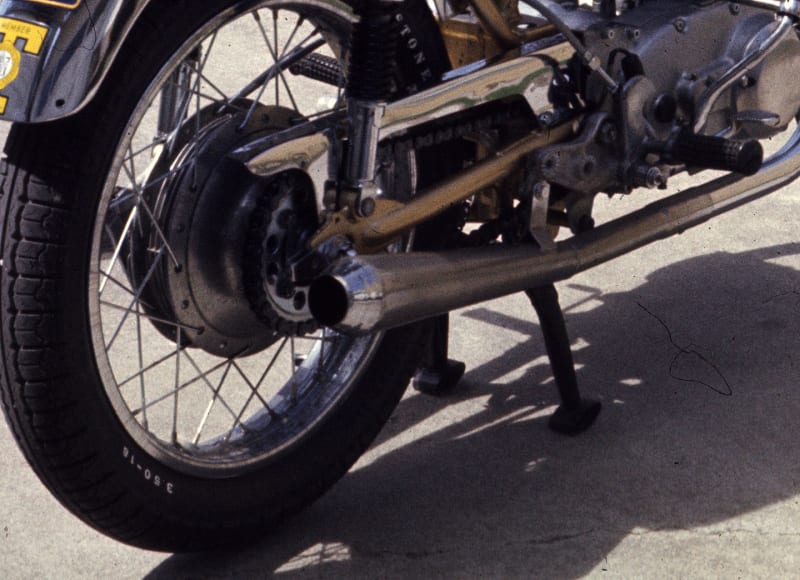
April 1974 (Minolta SRT-101)
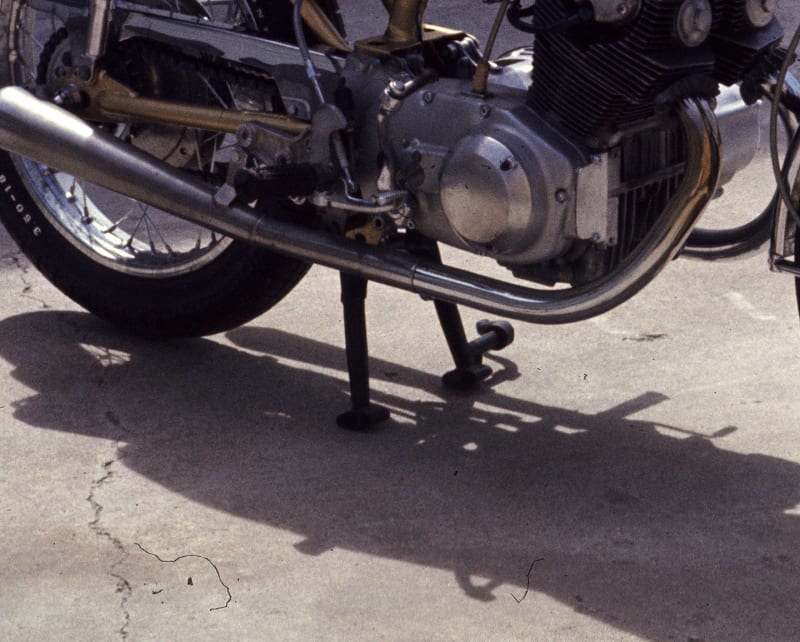
April 1974 (Minolta SRT-101)
John R. Baker, P.E. (ret)
Irvine, CA
Siemens PLM:
UG/NX Museum:
The secret of life is not finding someone to live with
It's finding someone you can't live without

April 1974 (Minolta SRT-101)

April 1974 (Minolta SRT-101)

April 1974 (Minolta SRT-101)

April 1974 (Minolta SRT-101)

April 1974 (Minolta SRT-101)
John R. Baker, P.E. (ret)
Irvine, CA
Siemens PLM:
UG/NX Museum:
The secret of life is not finding someone to live with
It's finding someone you can't live without
Compositepro
Chemical
Both wheels are still on the ground, so there may only be 20 lbs. of the bikes weight on the center stand. It only has to lift the bike a fraction of an inch to be stable. The stiffness of the suspension controls the force on the stand.
1. The weight of the bike comes over the top and settles slightly lower on a center stand so that it won't be as easily knocked off of the stand with a forward nudge. Note the forward angle of the center stand in the side shot.
2. Hard to say that both tires are truly on the ground, but even so, see point 1. above.
2. Hard to say that both tires are truly on the ground, but even so, see point 1. above.
JohnRBaker
Mechanical
Actually there was about a quarter-inch clearance under the rear tire, just hard to see, but I could engage the clutch while it was on the stand and the bike would not move (that's how I lubed the chain).
John R. Baker, P.E. (ret)
Irvine, CA
Siemens PLM:
UG/NX Museum:
The secret of life is not finding someone to live with
It's finding someone you can't live without
John R. Baker, P.E. (ret)
Irvine, CA
Siemens PLM:
UG/NX Museum:
The secret of life is not finding someone to live with
It's finding someone you can't live without
- Thread starter
- #16
Most bikes I've seen have very little weight one wheel, and the other wheel in the air when up on the center stand.
So, easy and conservative to assume that the center stand supports the full weight.
Once you make that assumption the problem becomes a simple vector decomposition using the angle of the stand.
No need to know the CG location, weight distribution, etc. Just a trigonometry problem.
By observation, and empirical experience, the first tug to get the lift started is the largest.
So, easy and conservative to assume that the center stand supports the full weight.
Once you make that assumption the problem becomes a simple vector decomposition using the angle of the stand.
No need to know the CG location, weight distribution, etc. Just a trigonometry problem.
By observation, and empirical experience, the first tug to get the lift started is the largest.
JohnRBaker
Mechanical
Thanks for the comments on the bike. For the record, this is what it looked like when I bought in in the Summer of 1973.
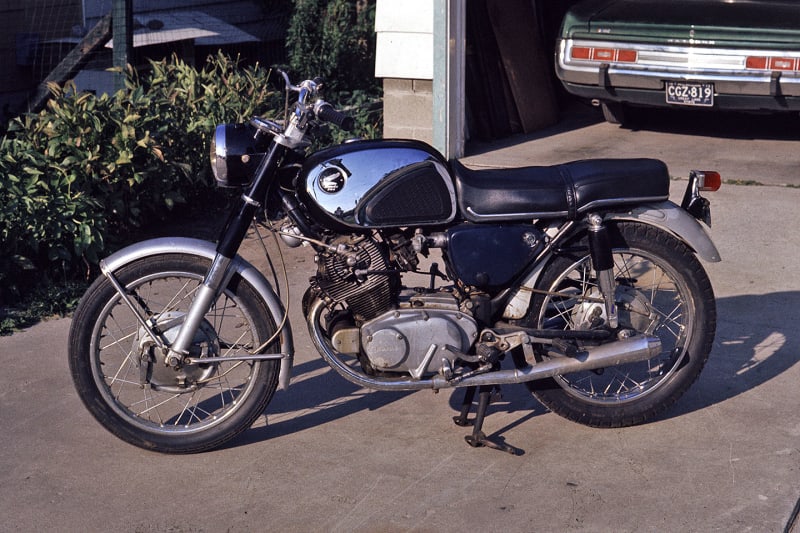
August 1973 (Minolta SRT-101)
I bought it from a co-worker whose son had bought in 1968, about a year before he was drafted and went to Vietnam. The only thing he had done was to replace the original stock mufflers with those megaphones. When the kid got back from the Army he wasn't interested in the bike anymore and so it had sat in his dad's basement for almost four years without being touched. I bought it without even trying to start it, but it looked like it was all there and nothing appeared to be broken or missing.
I then spent the winter, tearing it down and cleaning up the engine. I decided to paint it using the gold undercoating used when you paint something what we called 'Candyapple' back then, only unlike a bike I had rebuilt seven years earlier, when I was still in college, I only used the gold undercoat and several clear coats:
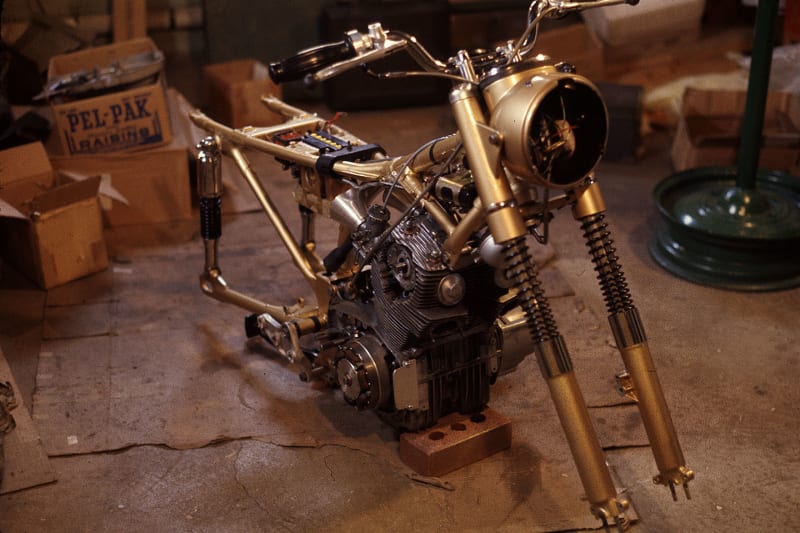
December 1973 (Minolta SRT-101)
And before anyone asks, here's that older bike, a 1965 Honda 305 Super Hawk, that I painted Candyapple Blue:
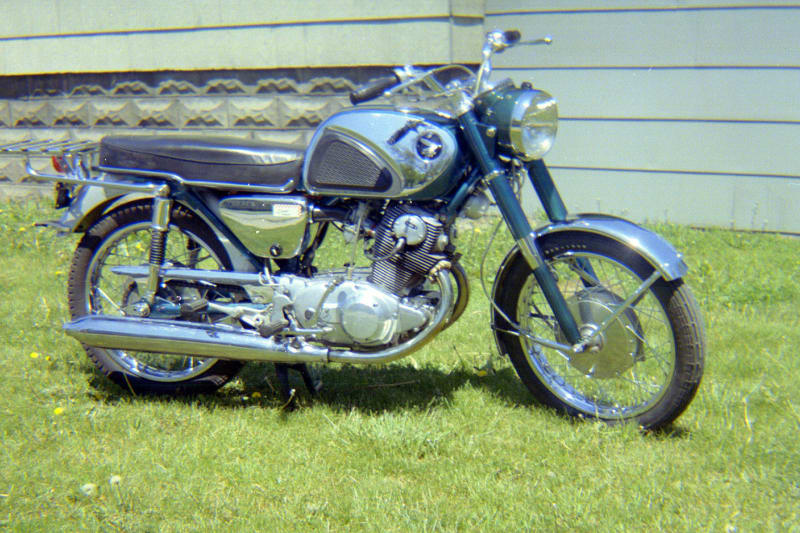
June 1967 (Kodak Brownie Twin 20)
For that last bike, it's the same gold undercoat, I just skipped the translucent color layer, and just used the clear top coat over the gold.
John R. Baker, P.E. (ret)
Irvine, CA
Siemens PLM:
UG/NX Museum:
The secret of life is not finding someone to live with
It's finding someone you can't live without

August 1973 (Minolta SRT-101)
I bought it from a co-worker whose son had bought in 1968, about a year before he was drafted and went to Vietnam. The only thing he had done was to replace the original stock mufflers with those megaphones. When the kid got back from the Army he wasn't interested in the bike anymore and so it had sat in his dad's basement for almost four years without being touched. I bought it without even trying to start it, but it looked like it was all there and nothing appeared to be broken or missing.
I then spent the winter, tearing it down and cleaning up the engine. I decided to paint it using the gold undercoating used when you paint something what we called 'Candyapple' back then, only unlike a bike I had rebuilt seven years earlier, when I was still in college, I only used the gold undercoat and several clear coats:

December 1973 (Minolta SRT-101)
And before anyone asks, here's that older bike, a 1965 Honda 305 Super Hawk, that I painted Candyapple Blue:

June 1967 (Kodak Brownie Twin 20)
For that last bike, it's the same gold undercoat, I just skipped the translucent color layer, and just used the clear top coat over the gold.
John R. Baker, P.E. (ret)
Irvine, CA
Siemens PLM:
UG/NX Museum:
The secret of life is not finding someone to live with
It's finding someone you can't live without
- Status
- Not open for further replies.
Similar threads
- Replies
- 21
- Views
- 14K
- Replies
- 5
- Views
- 15K
- Locked
- Replies
- 3
- Views
- 5K
- Locked
- Question
- Replies
- 15
- Views
- 5K
- Locked
- Question
- Replies
- 11
- Views
- 4K
